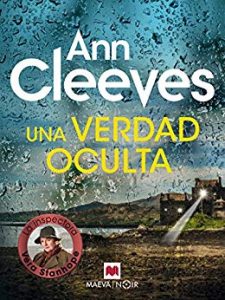A writer like Ann Cleeves represents the paradigm of retirement as a source of inspiration. But beyond the stigma of that loneliness so prolific for twisted plots like "The Shining" of Stephen King to "The Truth About the Harry Quebert Affair" by Joel dickerGood old Ann not only took advantage of that parenthesis apart from the world, for work reasons of her partner, but also established her literary career and began to work that demanding favor of the public.
Because Ann Cleeves, whose novels are now beginning to arrive in Spain Thanks mainly to its protagonist Vera Stanhope, she already has a good career behind her as a writer that began back in the 80s. Perseverance in her case achieved that success ultimately sought by any author. Although this insistence also demonstrates the ultimate will of the narrator by vocation, who never stops telling his stories, beyond the total volume of readers and billing.
With his sagas always circumscribed to criminal literature, in balance with that taste for deductive narrative inherited from the purest policeman, Ann Cleves is well known in many countries and its taking to television series ended up establishing it as another interesting reference of this prolific black genre that invades bookstores around the world.
Top 3 Recommended Books by Ann Cleeves
A hidden truth
Certain places have a beauty and charm whose scenery can become extremely sinister in the hands of a good editor. That's the case for Northtumberland and Ann Cleeves. Because this northern English area, bordering Scotland and watered by the North Sea offers landscapes of true luxury for any spectator or for a landscape painter.
Endless meadows with the naked eye, castles that emerge imposing between the plain and the sound of the waves that die quietly on the coast worn by millenary erosion.
Natural wealth and overwhelming silence, suggestions for a good retreat, but also an invitation to introspection, to dive into the recesses of the soul and of the drives that, in the case of human evil, is shocking.
So amid so much beauty, the discovery of a child killed by his own mother ends up giving us that raw slap. The small body lies in the bathtub, in a delirious composition of death and flowers.
La Inspector Vera Stanhope he handles the case and meddles in the coastal life of the locals. Lives that pass rocked in the mimetic calm of that space open to eternity. And this is how we delve into the future of the fate of Julie Armstrong, the dead boy's mother, or the chores of Peter Calvert, in whose house the next victim appears, a young woman sentenced to death in a similar presentation to that of the child.
Many other characters such as Samuel Parr or Clive Stringer arouse contradictory feelings, with that magical intention of presenting signs and suspicions in the reader, in the style of a Agatha Christie more up-to-date inspiration towards the black detective genre.
The inquiries and probes of Vera and her assistant Joe compose a strange map of souls, a script where the emotion or the last instinct that may have led to murderous madness slides like a strange premonition that augurs more victims.
A trap for crows
The taste for the natural as a setting for his plots served in this first novel of the Vera Stanhope saga to present his most successful series.
The proximity of the Pennines to the author's residence serves for that detailed knowledge that, in Ann's imaginary, draws on that fascination for inhospitable places as spaces where blackness acquires a special telluric magnetism.
And a biological investigation always awakens the feeling of threat to economic interests capable of defending the exploitation of resources or the pre-eminence of some status that grants patents over improvements or evolution.
That's why Rachel Lambert's team travels to the north end of this mountain formation with that sense of impending danger in the middle of nowhere. And death soon appears on the scene, with the sibylline intervention of those who can use it to silence wills. The arrival of Vera Stanhope occurs when everything begins to manifest as a macabre plan to remove Rachel and her companions from the planned investigation.
Silent souls
The ultimate consequence of death is silence. And who knows that well who uses it, the grim reaper, to cover up murky matters. In the history of literature and even in reality itself, investigations often come up against such plans for the perfect murder.
And if it were not for the persistence of characters like Vera Stanhope, it would be very difficult to find the link, the clue, the thread from which to pull towards an emotional motivation capable of murder as revenge.
Only in cases like Jenny lister, dead in the sauna, with the easy association with natural death from voluntary exposure to extreme heat, a minimal forensic investigation ends up pointing to strangulation.
And all this shortly before Vera herself entered the sauna to discover the deceased as an apparent woman in total relaxation. The woman's daughter Hannah is brought up to speed on the murder. And from then on we embark on one of those unstructured journeys among many potential culprits on which the sword of Damocles hangs with the same doubt.
A murder of this nature is written from relationships, from murky pasts. Between your assistant Joe Ashworth and Vera herself will be drawing that insane scheme towards a resolution that appears with the intensity and mystery of great police plots, the kind that are enjoyed as if you were accompanying the investigators, wanting to raise your own doubts and your most astute deductions.




I want the shetland book. DeAnn cleves based Spanish series this?
When are you going to translate new Ann Cleeves titles? I'm looking forward.
I do not know. But these from the Maeva publishing house are always at the helm when they rescue such good authors ...